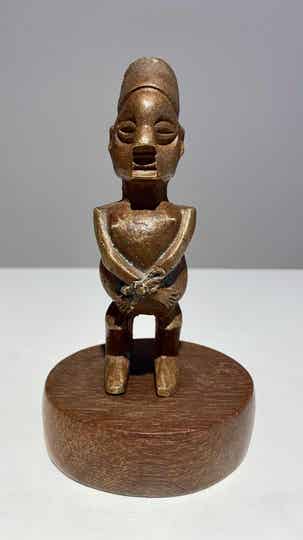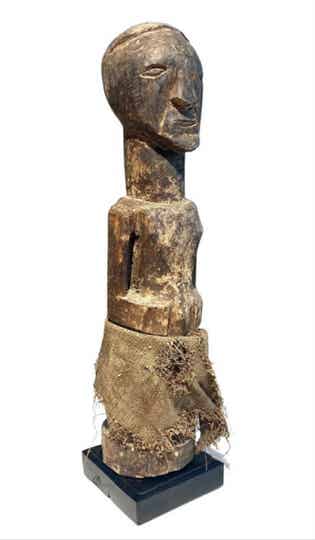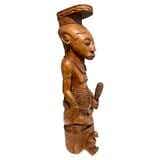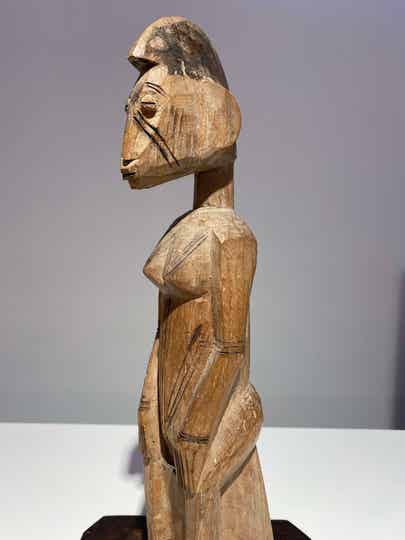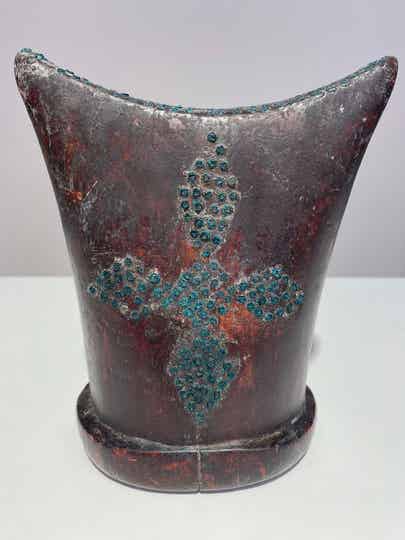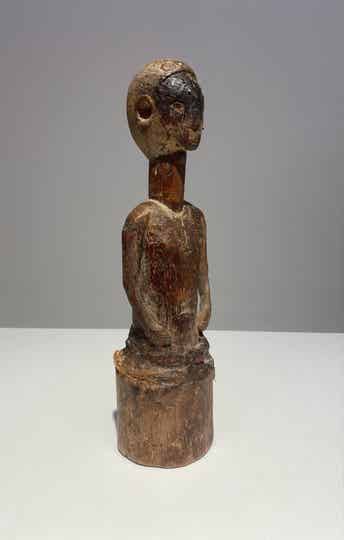Exceptional and very rare Ngiri Lobala Shield
Tribe : Ngiri / Mabo / Lobala / Ngbaka
Country : DR Congo / Ubangi region
19th Century - 1900
Museum Quality
Dimensions shield : Length: 147 cm x 49 cm
This type of shield is found in many african ethnic groups, whether Bantu or not. It is called nguba, guba, wara or gele according to these tribes. It is made up of several layers of braided fibers and an oval piece of wood serves as a handle. This basketry work was traditionally reserved for men, except in the Ngiri and Poto where women could exercise it. The name Nguba comes from the proto-bantu gùbà word which means «shield». The Obambas sometimes used animal skin to make them.
Old Rare and unusual Female Statue Of The Tshokwe / Chokwe Tribe - Dr Congo African Art Angola - 19th C.
Country of origin : DR Congo/Angola
Tribe : Tshokwe
Length = 15 cm
Very good condition
Ex Belgian colonial collection collected before 1940
This unusual statue most lickely represents a female clan ancestor. Notice the curved legs and cubistic torso. This museum quality wooden statue has a beautiful patina and is in very good condition
A museum quality Yaka kholuka mask ca 1900 DR Congo
People : Yaka
Region : DR Congo / Kwango region
Collected by the Jezuits (mbala written inside the mask)
Ex Belgian collection Liège / Belgium
Height : 78 cm
The Yaka people of Angola and the Democratic Republic of the Congo have a male initiation society known as Makunda or N’khanda, which is charged with circumcising, hazing, and teaching boys to become a man (mainly, education in hunting and sex). During the circumcision dance performances (kinkanda), the initiates wear special masks while their teachers alone are permitted to wear the ritual masks of the Makunda. After initiation, the boys are led out of seclusion and back into the community. Before festivities can begin, the head teacher (kahyuudi or kayudi) commissions a carver (nkalaweeni or mvumbwa) to create a series of masks. Many types of masks are worn or danced in succession during the final initiation feast.
The kholuka, also known as a mbaala, is worn either by the leader of the initiation or the senior initiate. It is the last danced, and it is danced alone to signal the end of the initiation ceremony. Unlike the other masked dances, which are entertaining to the audience, the kholuka creates a sense of unease due to the overtly sexual behavior of the dancer. This particular mask has an elephant puppet on top.
A superb rare museum African art mask. A few similar are at the africa museum Tervuren Belgium
For more on Yaka masquerade, see Arthur P. Bourgeois, Art of the Yaka and Suku (1984).
Superb museum quality and extremely rare fine quality Tshokwe /Chokwe Lwena wooden tobacco snuff container or mortar late 19th/early 20 th century DR Congo / Angola
Tribe : Tshokwe / Chokwe / Lwena
Country DR Congo border with Angola
Height : 16 cm
Belgian colonial collection collected before 1940 !
This most beautiful tobacco container represents a female Tshokwe / Chokwe clan ancestor. The use of tobacco was widespread among the Tshokwe.
A rare museum piece in superb condition.
Very old extremely tall Yaka tribe antropomorph statue DR Congo 19th century ex Belgian colonial collection
Tribe : Yaka
Country : DR Congo / Kwango region
Age : 19th century
Height : 91 cm
This particular antropomorphic satue is 1 of the tallest known Yaka statues in collections. Magical sustances in the abdomen clearly suggests that the statue was used in rituals as healing and the khita-fertility cult. Clearly there is an influence from the Bakongo tribes as the Kongo / Yombe and others.
A museum quality very rare old mask for a top private collection or museum collection.
Superb antique and rare museum quality seated female wooden statue from the Dogon / Bamana tribe Mali/Burkina Faso
Tribe : Dogon/ Bambara / Bamana
Country : Maili / Burkina Faso
Height : 36 cm
Ca 19th century / 1900 / early 20th century
Rare female wooden seated statue from the Dogon tribe located in Mali.
The Dogon are a tribe located in central Bandiagara plateau Mali . Statues from this tribe are particularly scarce. This statue is a most beautiful carving from the Dogon tribe and in exccellent condition.
19th century Senufo helmet mask of the Korobla type
Tribe : Senufo / Senoufo
Country : Ivory Coast / Côte d'Ivoire
Type mask : korobla / korubla
Length mask : 42 cm and 26 cm high
A superb 19th century museum quality Senufo firespitter wooden helmet mask.
Members of the Poro society, a “secret men’s society,” wear it during the funeral ceremonies of their deceased members to honor them as well as well as ward off evil spirits.
The appearance of a Korobla mask is a mixture of several animals. According to Goldwater, the mask “can include iconographic details taken from the buffalo, the warthog, the crocodile and the antelope, in its larger parts, plus small representations of a chameleon and a bird, even sometimes a snake”. The Korobla in the PLU collection seems to be a possible mixture of antelope with its long curved horns at the top of its head, possibly a hyena or another animal with pointed ears, and a crocodile with its long jaw and mouth full of sharp teeth.
There are multiple interpretations of what the meaning of the Korobla mask’s appearance and purpose is. Some say it is to inspire fear in the viewers of the ceremony, while others say it is to protect the soul of the deceased by scaring away evil spirits and soul eaters.
Unique and very rare Songye Nsapo ritual or ceremonial kilonda axe
Tribe : Songye/Nsapo/Songe
Country DR Congo
Before 1940
A very rare kilonda axe with 3 heads on the side of the blade which is very uncommon. On the axe blade are a total of 9 iron heads.
A very interesting and an unique collectors item of museum quality.
The total length of the axe diagonal = 48 cm.
Bamana female statue Bambara Mali African ART Malinke Marka 19th Century
A superb antique 19th century Bamana / Bambara female statue from Mali
People : Bamana / Bambara
Country : Mali
Age : 19th century
The anthropomorf jonyelini / jo female statue has scarifications on the body.
Beautiful patina of use.
In very good but used condition
Lenght = 66 cm measured without the wooden base.
Will be sold with wooden base
Suku helmet mask with antilope DR Congo ca 1930
Rare beautiful museum quality authentic Suku Helmet Mask (Hemba type) DR CONGO ca 1930.
Beautiful patina with traces of polychrome
Art gallery Decoster / Belgium
Note : Throughout southern Democratic Republic of the Congo and Angola, brightly painted and decorated masks are used to mark the transition to adult life. during the initiation period, which may last a year or more, adolescent boys are separated from the village and made to undergo a series of ordeals, including circumcision, designed to measure their strength and courage. These tests often culminate in the boys' symbolic death as children and rebirth as men. Among Yaka and Suku peoples, the conclusion of mukanda--coming to manhood rites--is accompanied by performances of kholuka masks. The imagery that surmounts these masks translates into visual form the lyrics of songs that emphasize gender differences. Figural representations of humans and animals ridicule women and celebrate male virility. Contemporary works reinforce generational continuity and male solidarity by incorporating the ashes of masks danced on the occasion of preceding mukanda.
Senufo Stool Senoufo Ivory Coast Côte d'Ivoire African Tribal Art - 19th century
A very big quite heavy 19th century Senufo Stool
Tribe : Senufo / Senoufo
Country : Ivory Coast / Côte d'Ivoire
Length = 72 cm
Height = 32 cm
A very big Senufo stool carved from a single block of wood. The wood is tough, dense and very durable. Shown with cone style legs. A superb piece from the 19th century.
Will only be shipped with track and trace DHL Delivery service
A most beautiful Bird Beak Mask From The Dan Tribe Ivory Coast Liberia Diomandé ca 1930
Serves as a Protection or justice mask.
People: Dan or Diomandé
Country: Ivory Coast / Liberia
Length: 27 cm
Around 1930
A very beautiful crusty patina
Excellent mask in top condition
Kusu / Bembe wooden ancestor figure DR Congo ca 1900
Tribe : Kusu / Bembe / Hemba
Country : DR Congo
Era : ca 1900 / early 20th century
Height : 29 cm
Nicely carved Kusu / Congo statue with beautiful face / almond shaped eyes and triangular face with beard. Top of the head is a big hole to charche the powerful statue and has patina of age and use. This statue, used for worship, represented the ancestor who is being honoured. The Kusu's religious practice was also influenced by its neighbours. All of them share common beliefs; they recognize the Vilie (supreme being), and worship ancestors and various nature spirits. In fact, the Kusu use powerful magical figures similar to those found among the Songye. Kusu societies, with their mysterious past, nevertheless developed workshops based on their own traditions, at the confluence of these diverse and sometimes contradictory influences: they stand out most for "a determinedly ring-shaped technique, polymorphous faces with flat, even concave surfaces, with almond-shaped eyes set close together and touching the base of the nose.
A museum quality statue for a top private collection or museum collection.
Luba-Hemba kabeja janus wooden figure DR Congo ca 1900
Tribe : Luba-Hemba / Hemba
Country : DR Congo
Era : ca 1900
Height : 33,5 cm
In Southeastern Democratic Republic of Congo, the Hemba people inhabit vast plains surrounded by high hills and bordered by streams, rocks, and marshes. Their social organization is founded on a system of clans that bring together several families sharing a common ancestor.
These double figures, called ‘kabeja', always represent a man and a woman, back to back. They represent the ‘ancestor’ couple of the Hemba people and are preserved exclusively in the houses of the clan and village chiefs, as legitimation of the latter’s status and power as well as for the protection of the clan members.
A museum quality statue for a top private collection or museum collection.
Fon people Royal Scepter recade Dahomey Kingdom 19th century
Royal scepter / recade Makpo
Lions head scepter symbol for King Gbehanzin (1845-1906)
Tribe : Fon
Country : Benin (Dahomey)
Era : Second half 19th century
Length : 53 cm
This scepter (known among the Fon peoples as makpo, or staff of fury) belongs to works that served as objects of power and prestige to rulers of the Fon Kingdom of Danhomè in present-day Republic of Benin, a West African nation state. In the eighteenth and nineteenth centuries, the Kingdom of Danhomè prospered as a major political power and commercial center situated off the Gulf of Guinea. It gained much of its power by playing an active role in the international slave trade. Since the seventeenth century until the conquest of the kingdom by France in 1894, generations of Danhomè kings served as great patrons for the arts, often commissioning items to enhance their own royal status, or to commemorate their predecessors.
Art historian Suzanne Preston Blier explains that the scepter’s overall shape derives from a genre of throwing-stick weapons introduced to Danhomè in the 17th century under the dynasty’s founder, Huegbadja (reigned c. 1645-1685). A distinctive royal symbol typically adorns such scepters to link them to either the commissioning or commemorated king. This scepter’s finial in a shape of a pineapple connects it to King Agonglo, who reigned from 1789 until 1797. In the Fon language, the word for pineapple is agon, which because of its similarity to the name Agonglo became a pictogram for the ruler’s name. Renowned for his art patronage, Agonglo is credited with developing the artistic tradition of the royal scepters. A century later, Agonglo was established as King Gbehanzin’s sponsoring ancestor and protective spirit (djoto). Gbehanzin ruled from 1889 until 1894 and during this time, commissioned this work to honor his ancestor (Blier 1998).
Very old Songye male nkishi power statue DR Congo
Tribe : Songye
Country : DR Congo
Age : late 19th century - ca 1900
Height : 30 cm
A very powerful extremely well carved nkishi statue from the Songye people. Statues like these were used as protection. This particular statue has magical substances on top of the head and on the navel. The style is can be situated in the western part of the Songye region, more specific the Tempa region.
A museum quality statue for a top private collection or museum collection.
Very rare superb African Art item.
Very old Yaka tribe zoomorphic pig of leopard mask DR Congo
Tribe : Yaka
Country : DR Congo / Kwango region
Age : late 19th century
Height : 30 cm
This particular zoomorphic pig or leopard mask was used in connection with the initiation and sequestering the young boys during the mukanda in the bush.
Animal masks like these with their visible teeth are quite agressive because they needed to protect the young boys against evil forces. When the boys are dancing with the masks, the handle was used to hold the mask.
A museum quality very rare old mask for a top private collection or museum collection.
Very old Songye / Tetela nkishi power statue DR Congo
Tribe : Songye
Country : DR Congo
Age : late 19th century - ca 1900
Height : 32,5 cm
A very powerful well carved nkishi statue from the Songye or Tetela people. Statues like these were used as protection.
This statue still has the original raffia cloth. Beautiful original deep patina.
A museum quality statue for a top private collection or museum collection.
SOLD
South African Zulu Prestige horn knobkerrie or Sceptre Club from the early to mid 19th Century
Tribe : Zulu / Nguni
Country: South Africa
Length = 56,5 cm
Period: 19th century (1820-1870)
Perfect condition
A prestigious horn sceptre club which most lickely belonged to a high ranking nobleman or even a Zulu king. The head of the club has carvings or decorations which is extremely rare. This museum piece is in excellent condition.
A Ga'anda / Ganda spririt terracotta jar. Eastern Gongola Valley, Nigeria. 19th century
Tribe : Ga'anda / Ganda.
Country : Nigeria
Period : 19th century
Length : 47 cm high
Excellent condition
This jar of the mbirhlen'nda type from the Ga'anda tribe was a spritual item and used as a funerary vessel.
A very rare museum quality item in excellent condition.
Ngaady a mwaash mask from the Kuba Kingdom DR Congo ca 1880. Extremely rare unusual museum quality mask!
Country of origin : DR Congo
Tribe : Kuba
Length = 40 cm high and 21 cm wide
Very good used condition
Extremely rare museum quality mask.
This Ngaady a Mwaash mask (c.1880) represents the primordial female of the Kuba people in what is now the Democratic Republic of Congo. Queen Ngokady, a notable Kuba woman, created the mask, highlighting the important cultural and political contributions of women in the Kuba royal court. The aesthetic taste and noble attitude of the Kuba are embodied in the formal attributes of this mask which is a powerful representation of status and beauty. The beadwork that covers the mouth symbolizes the composure and quietness of women. The red in the mask represents suffering and the blood of menses and childbirth, the striated lines extending from her eyes and running down her cheek are tears. The black of the triangles signifies the hearth of the king’s home and the domesticity therein, the white of the mask the mourning of women and the blue, Ngaady a Mwaash’s royal status.
The Ngaady a Mwaash has two mythical brothers who perform a mock fight to win her affection: the Mwash aMbooy represents the Kuba king, and the Bwoom mask the half-brother/foreigner. The museum is fortunate to have masks of all three in the African Collection. The three masks offer a poignant manifestation of the significance of women and the balance of gender and status in Kuba political systems and Kuba life.
Old Rare and unusual Statue Of The Tshokwe / Chokwe Tribe - Dr Congo African Art Angola - Early 20th C.
Country of origin : DR Congo/Angola
Tribe : Tshokwe
Length = 29 cm
Perfect condition
This unusual statue with very important scarifications on the belly represents most lickely a female clan ancestor. This museum quality wooden statue has a beautiful patina and is in perfect condition
SOLD
Luba Royal Caryatid Seat/ Tabouret DR Congo Early 20th Century.
Tribe : Luba Shankadi
Country : DR Congo
Height : 35 cm
Age : early 20th century
Luba leaders trace their ancestry to a dynasty of sacred kings, and Luba royal seats are intended to replicate an original seat of office owned by the progenitor of this divine lineage. Such works associate their owner with the source of his legitimacy.
Despite their functional form, royal stools are never used for sitting but, rather, are sacred insignia preserved within a king's palace. They serve as metaphorical, not literal, seats of kingship. The design of Luba seats of leadership may either be abstract or figurative. Those incorporating female caryatids give expression to the Luba conception of the female body as a spiritual receptacle that supports divine kingship. The aesthetic refinement of the female body through elaborate skin ornamentation and coiffure serves as a metaphor for the civilization and refinement that Luba rulers disseminate within society.
Notice the cascade shaped coiffure which refers to the Luba Shankadi people of DR of Congo.
Old Rare Statue Of The Tshokwe / Chokwe Tribe - Dr Congo African Art Angola - Early 20th C.
Old and exceptional statue Of The Tshokwe / Chokwe / Lwena Tribe - Dr Congo African Art - early 20th century (circa 1910-1930)
Country of origin : DR Congo/Angola
Tribe : Tshokwe
Fetish Tshibinda (Ilunga) or Yanga
Protector of hunters / Territiore Tshikapa Kasai
Batshoko Group /
Tulunda Clan
Length = 39 cm
Perfect condition
SOLD
Nkishi Statue People Songye / Songe - DR Congo African Art Late 19/early 20th
Tribe : Songye / Songe
Country : DR Congo
Length : 17 cm
Age : late 19th century / early 20th century
A very powerful well carved nkishi statue from the Songye people. Statues like these were used as protection.
Very special carved face and eyes.
A museum quality statue for a top private collection or museum collection.
Mbuya Type Mask From The Pende Tribe DR Congo
Tribe : Pende
Country : DR Congo
Length : 34 cm
Age : early 20th century
Wooden mask / Natural fiber headdress / raffia beard
Old Belgian collection
Very good / Perfect condition
Beautiful patina of use and age
Ancient And Exceptional Anthropomorphic Statue / Door Lock Of The Bamana Mali People 19th century
Tribe : Bamana or Bambara
Country : Mali
Length : 48 cm
Age : 19th century
The Bambara or Bamana are a Mandé ethnic group native to much of West Africa, primarily southern Mali, Guinea, Burkina Faso and Senegal. Today they make up the largest Mandé ethnic group in Mali.
A superb quality 19th century old and exceptional anthropomorphic door lock of the Bamana people
Mali. A beautiful patina of use and age.
Ancient And Exceptional Anthropomorphic Statue From The Pende Tribe Dr Congo Kasaï Region -19th century
Ancient And Exceptional Anthropomorphic Statue From The Pende Tribe
Dr Congo
Kasai Region
Period: late 19th century
Height: 48 cm
Very good condition (feet missing)
The Pende people are an ethnic group in the south-western Democratic Republic of the Congo. The Pende are divided into two cultural groups: the Eastern Pende and the Western Pende who are distinct but consider themselves part of the same ethnic group.
This rare Pende statue from the 19th century represents a clown.
Superb museum quality and extremely rare fine quality Tshokwe /Chokwe wooden cariatide late 19th/early 20 th century DR Congo / Angola
Tribe : Tshokwe / Chokwe
Country DR Congo border with Angola
Height : 30 cm
This most beautiful exclusive stool represents ancestor who is holding her head between her head. The ancestor complains that the descendants neglect their cult and calls for the cult to be honored more regularly.
A true museum piece in superb condition.
Superb museum quality Ngbandi wooden statue 19th century DR Congo Ubangi region
Tribe : Ngbandi / Mbanza
Country : DR Congo
Length : 45 cm
This female statue represents an important mythical ancestor among the Ngbandi tribe. The female figure most lickely represents Nabo, the sister of the mythical hero Seto.
A most rare and powerful statue.
Antique superb rare Lobi or Bwa stool Burkina Faso / Mali region
Tribe : Bwa or Lobi
Country : Burkina Faso / Mali
Late 19th / Early 20th century
Length : 35 cm
Perfect condition / exceptional condition
The Bwa live in central Burkina Faso and south-east Mali, between Mali's Bani River and the Mouhoun River (Black Volta) in Burkina Faso. Their total population is approximately 300,000.
A superb museum quality anthropomorphic stool
Old Tutsi Basket Type Ibeseke/Igiseke - Rwanda
Tribe : Tutsi
Country : Rwanda
Very rare and superb piece of exceptional quality and aesthetics
Tutsi basketry
Late 19th / Early 20th century
Height: 17.5 cm
Perfect condition / exceptional condition
SOLD
Superb museum quality Holo mvunzi wooden statue late 19th/early 20 th century DR Congo / Angola
Tribe : Holo
Country DR Congo border with Angola
Length : 46 cm
Traces of bleu and green pigments
The cult statue mvunzi, represents an ancestor carved with slightly bent legs and her hands joining on the abdomen. The crested hairdo, proportioned body, scarified face with coffee-bean eyes, bent legs and blue polychrome characterizes their Holo’s Art Style. The Holo are a small Matriarchal Tribe living in Kwango Area on the DRC-Angola border (population of +/- 6000 in DRC). Holo sculpture is very varied due to the influences of their culturally dominant neighbors: Suku, Yaka, Lunda,Tshokwe and others.
Beautiful and rare type kifwebe mask from the Songye / Luba Democratic Republic Congo
Tribe : Luba/Songye
Country : DR Congo
Height : 43 cm / Width : 28 cm
Early20th century
They were used in ceremonies of the Kifwebe secret societies where dances of the same name were performed.
This particular mask is quite big and has white, red and black pigmented carved lines running over the mask.
A rare Senufo female with hornbill face tugubele wooden statue late 19th century
Tribe : Senufo / Senoufo
Country Ivory Coast / Côte d'Ivoire
Age : 19th / early 20th century
A most curious and extremely rare Senufo statue representing a female anthropomorphic statue with a hornbill head.
Some Senufo heddle pulleys are known with a hornbill head and beak. However statues with a hornbill face a quite rare.
Lovely carving and patina of age and use.
Antique superb Pende mbuya mask DR Congo late 19th century
Tribe : Pende
Country : DR Congo
Age: late 19th / early 20th century
Stylistically, the best known masks come from Katundu: the convex and triangular face is divided by a V-shaped eyebrow line integrated into a heart-shaped depression; the heavy eyelids are drooping; the nose is blunt and sometimes slightly turned up; finally, the mouth, whose corners pull downwards, has cut teeth.
Traditionally, African Mbuya masks such as this one were danced during the mukanda, the initiation that leads young men from puberty to adulthood.
Antique used pipe of the Ngbaka tribe Dr Congo ca 18880/1900
Tribe : Ngbaka / Mbanza / Ngbandi / Ngombe / Banda / Bwaka / Mbaka
Country : DR Congo Ubangi region
Ca 1880/1900
Length = 27 cm
Wood, copper, aluminium, seads and fibres
A well used boka type Ngbaka pipe with human head and metal inlay. A superb high quality piece originated from the Ubangi region.
Exceptional Gbilija Shield from the Zande tribe- DR CONGO
Tribe : Zande
Country : DR Congo
Period: 19th Century / 1900
Length: 113 cm x 52 cm
Museum Quality shield
Basketwork / vegetal fibre / wood
Very rare shield in excellent condition.
The Azande were organized into chiefdoms that can also be called kingdoms. The Avongara were the nobility and passed it down through their lineage. chiefs had many roles within the chiefdoms such as being military, economic, and political leaders. All the unmarried men were laborers and warriors. This shield belonged to a Zande (Azande) warrior.
SOLD
Antique magnificent Tshokwe / Chokwe mwana pwo mask DR Congo / Angola
Tribe : Tshokwe / Chokwe
Country : DR Congo / Angola
Age : Late 19th century/early 20th century
Mwana pwo mask with filed teath. A popular and frequent occurrence in entertainment masquerades, mwana pwo represents a female ancestor but is always worn by a male dancer. This mask type symbolizes fecundity and the prominent role of women in Chokwe society. Although idealized, its features suggest the individuality of a portrait, raising the possibility that it may be modeled on a particular woman. Mwana pwo often features elements of beauty such as scarification and hairstyles.
Wooden mask with traces of red occre/pigments.
A rare superb Mangbetu wooden shield DR Congo 19th century
People : Mangbetu
Country : DR Congo / Uele region
Wood / Fibers
Dimensions : 119 cm x 66 cm
During the second half of the nineteenth century, when these kingdoms were most powerful, Mangbetu aristocrats surrounded themselves with a wide variety of finely crafted utilitarian objects--boxes, jars, stools, musical instruments, and weapons.
This rare type of wooden shield was used by Mangbetu warriors.
SOLD
Superb 19th century Kuba pipe DR Congo
People : Kuba
Country : DR Congo, Sankuru River
Late 19th century
Wood / 3 messing nails / metal / copper
This elaborately carved and ornamented tobacco pipe was not merely a functional smoking implement, but was also emblematic of its owner’s status.
This work was commissioned during the unprecedented economic and artistic growth of the late nineteenth or earlier twentieth century Kuba kingdom. It closely resembles the figurative drinking vessels that Kuba elites—particularly men—used to drink palm wine (maan), a sweetly sour alcoholic beverage.
Early 20th century Zombo circumcision and initiation mask DR Congo
Tribe : Zombo
Country : DR Congo / Angola
Height : 42 cm
This very rare Zombo mask has been used during inittiation and circumcision rites for boys/young men.
A superb very high quality African Art piece and rare mask for top private collections / museum collctions.
Very old Songye / Tetela nkishi power statue DR Congo
Tribe : Songye or Tetela
Country : DR Congo
Age : 19th century
Height : 68 cm
A very powerful well carved nkishi statue from the Songye or Tetela people. Statues like these were used as protection and even were used on battle fields. The red occre colour could suggest this statue served even on the battle fields.
This statue still has all his original attributes.
A museum quality statue for a top private collection or museum collection.
Beautiful and rare type kifwebe mask from the Songye / Luba Democratic Republic Congo
Tribe : Luba/Songye
Country : DR Congo
Height : 37 cm
Ealry 20th century
Of this particular kifwebe mask style ar only about a dozen known to exist in collections.
They were used in ceremonies of the Kifwebe secret societies where dances of the same name were performed.
Ex Belgian colonial collection collected before 1950
SOLD
Antique Mangbetu tribe female Statue - DR Congo Region Uele - 19th century
Tribe : Mangbetu
Country DR Congo
Age : 19th century
30 cm high
Refined Mangbetu female figurine, Democratic Republic of Congo. Red-brown patina and fine carved scarifications on torso. Late 19th century.
Note : The Mangbetu people of North-eastern Democratic Republic of Congo impressed early travelers with their political institutions and their remarkable skills in the arts, as builders, potters, and sculptors. This figure’s features are meticulously rendered through delicate modeling, incised graphic embellishments on the visage and body. The quality of the carving equals the most refined examples of Mangbetu statuary.
Senufo funeral ritual anthropomorph buruw trumpet or horn Ivory Coast 19th century
Tribe : Senufo / Senoufo
Country : Ivory Coast / Côte d'Ivoire
Age : 19th century
Height = 90 cm
These type of ritual trumpets were used long time ago during funeral rites among the Senufo. Beautitul extremely rare item with patina of age and use.
Extremely old unique Luba Royal caryatid enthronement emblem 19th century
Tribe : Luba
Country : Democratic Republic Congo
Age : Mid 19th century
Height = 52 cm
This Luba Royal caryatid stool from DR Congo Luba was in the 19th century used a Royal enthronement emblem. Luba leaders trace their ancestry to a dynasty of sacred kings, and Luba royal seats are intended to replicate an original seat of office owned by the progenitor of this divine lineage. Such works associate their owner with the source of his legitimacy.
Despite their functional form, royal stools are never used for sitting but, rather, are sacred insignia preserved within a king's palace. They serve as metaphorical, not literal, seats of kingship. The design of Luba seats of leadership may either be abstract or figurative. Those incorporating female caryatids give expression to the Luba conception of the female body as a spiritual receptacle that supports divine kingship. The aesthetic refinement of the female body through elaborate skin ornamentation and coiffure serves as a metaphor for the civilization and refinement that Luba rulers disseminate within society.
Notice the elaborate cross shaped coiffure, the filed teeth and tong between teeth and lips. The stool can be dated between 1850-1880. Most likely Kisula-Mwanza workshop est bank of the River Zaire (see François Neyt, Luba to The Sources of the Zaire, 1994, p.77-88)
An extremely rare museum quality Bobo antilope wooden helmet mask
People : Bobo / Grunsi / Bwa
Country : Burkina Faso / Mali
19th century / early 20th century / Length= 64 cm
This genre of helmet mask, known as bolo (pl. bole), is worn by blacksmiths at important agricultural celebrations, initiation rites, and funerals in Bobo communities. In performances, bole function primarily to provide entertainment while other, older mask types are considered more sacred and carry greater spiritual weight. Bole may take two distinct forms, the full helmet type seen here or a three-quarter one. The prominent sagittal crest is a defining characteristic of bole. This example's facial features are roughly hewn, but accented by a number of exquisite details. The mouth, for example, with its protruding lips, also incorporates round sticks set into holes that form two rows of teeth. The oval-shaped eyes are highlighted by animal hair attached to the lids and brow ridge, giving this face eyelashes as well as eyebrows. The surface of the mask is incised with numerous vertical and diagonal lines that create intricate geometric patterns of triangles and squares. The incised patterns are accentuated with alternating schemes or red, white, and blue/black pigments. The triangles may represent leather Muslim amulets thought by non-Muslim Bobo to contain magical properties. An extensive fiber costume is attached to the holes at the base of the mask to cover the performer, who is invariably a male dancer. Bole most commonly represent human subjects, thus the anthropomorphic appearance of this mask; however, there are other types of bole that represent various animals, including the antelope, ram, monkey, and rooster.
19th century superb wooden Ngombe backrest
People : Ngombe
Country : Democratic Republic of the Congo
Late 19th / early 20th century
Length = 47 cm
The Ngombe—“water people”— inhabit the Itimbiri-Ngiri and the triangle formed by the Congo and the Ubangi. Other fisherfolk of the marshes dwell in the lagoons and the flooded forests of the region where the confluence of the Congo and the Alima, Likouala, and Sangha occurs.
A 19th century Senufo helmet mask of the kponyugu type
Tribe : Senufo / Senoufo
Country : Ivory Coast / Côte d'Ivoire
Type mask : wanyugu / kponyugu / wabele
Length mask : 50 cm and 26 cm high
A superb 19th century museum quality Senufo firespitter wooden helmet mask.
Members of the Poro society, a “secret men’s society,” wear it during the funeral ceremonies of their deceased members to honor them as well as well as ward off evil spirits.
The appearance of a Kponyungo mask is a mixture of several animals. According to Goldwater, the mask “can include iconographic details taken from the buffalo, the warthog, the crocodile and the antelope, in its larger parts, plus small representations of a chameleon and a bird, even sometimes a snake”. The Kponyungo in the PLU collection seems to be a possible mixture of antelope with its long curved horns at the top of its head, possibly a hyena or another animal with pointed ears, and a crocodile with its long jaw and mouth full of sharp teeth.
There are multiple interpretations of what the meaning of the Kponyungo mask’s appearance and purpose is. Some say it is to inspire fear in the viewers of the ceremony, while others say it is to protect the soul of the deceased by scaring away evil spirits and soul eaters.
Very rare and exceptional Fang Warrior Ax
People: Fang
Country Gabon - Cameroon - Equitorial Guinea
Period: Early to mid 19th Century
Length: 50 cm
Very good / almost perfect condition
The Fang are known as warriors and this battle axe was exceptional beautiful museum quality axe most lickely survived several battle fields.
Price = 1100 euro
Exceptional and very rare Ngiri Lobala Shield
Tribe : Ngiri / Mabo / Lobala / Ngbaka
Country : DR Congo / Ubangi region
19th Century - 1900
Museum Quality
Dimensions shield : Length: 140 cm x 48 cm
This type of shield is found in many african ethnic groups, whether Bantu or not. It is called nguba, guba, wara or gele according to these tribes. It is made up of several layers of braided fibers and an oval piece of wood serves as a handle. This basketry work was traditionally reserved for men, except in the Ngiri and Poto where women could exercise it. The name Nguba comes from the proto-bantu gùbà word which means «shield». The Obambas sometimes used animal skin to make them.
SOLD
Unique and very rare Songye Nsapo ritual or ceremonial kilonda axe
With 2 complete copper/messing statues.
Tribe : Songye/Nsapo/Songe
Country DR Congo
Before 1940
A monumental kilonda axe with 2 messing figures and a total of 22 iron heads.
The 2 figures have male and female features and look like androgyn small metal statues which makes it even more interesting and an unique collectors item of museum quality.
The wooden grip has lizard skin.
The total length of the axe = 60 cm.
SOLD
Unique extremely rare Fang throwing blade from Gabon
Unique extremely rare Fang throwing blade from Gabon / the Sangha region, Ngumba, So, Makaa, Djem, Konabem, Mpyemo, Bumali, Fang from Cameroon, and Kele people
19th century
A very similar throwing knife can be found in the collection of the Pitt Rivers museum and was acquired in 1899, attesting the old age of the type. Its new owner will be delighted with the purchase as the opportunity to find a knife like this is extremely rare.
SOLD


